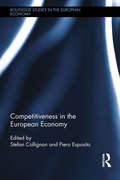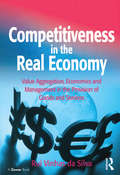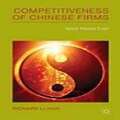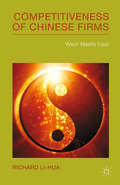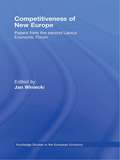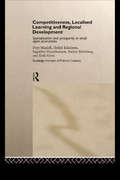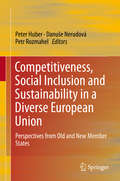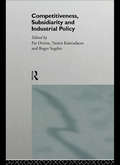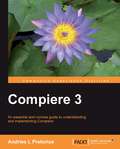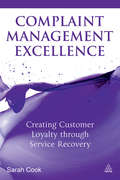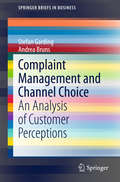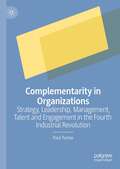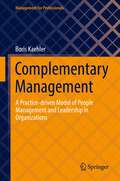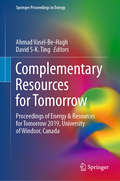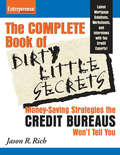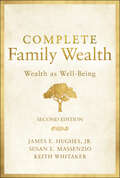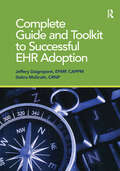- Table View
- List View
Competitiveness in the European Economy: Competitiveness In The European Economy (Routledge Studies in the European Economy)
by Stefan Collignon Piero EspositoThis book deals with the relationship between the competitiveness of countries in Europe and the analysis of macroeconomic imbalances. It focuses mainly on a European analysis, along with special studies of the German economy, which is rarely considered to be a cause for the current crisis. The book also compares Germany with Italy, providing a comparative perspective on structural reforms. The first part of this book analyses macroeconomic imbalances based on a new framework from the analysis of the flow of founds rather than balance of payments, and presents an alternative measure of unit labour cost comparisons to investigate the relationship between imbalances and competitiveness. The second part is dedicated to the analysis of the trade performance of Germany and Italy and the sustainability of the German model in the EMU. The third part describes the reform policies implemented by Germany and their effect on imbalances; this includes wage moderation, the labour market reforms and weak labour demand. The final part explores the regional inequalities within Germany and Italy, providing useful lessons regarding fiscal federalism and regional banking developments. In conclusion, a big part of the problems within the Euro Area are generated by the use of a wrong framework of analysis, where the EMU is considered as a fixed exchange rate regime and not a single country. This book provides an alternative view which holds at the core the relationship between sectors. It is stressed throughout the book that the German behaviour has contributed to the rise of imbalances between countries due to its growth model, not suitable for a big developed country in a currency union. This book also finds that stressing banking integration within countries helps to reduce regional inequalities, which has important implications for the management of Europe’s future banking union and macroeconomic imbalances.
Competitiveness in the Real Economy: Value Aggregation, Economics and Management in the Provision of Goods and Services
by Rui Vinhas SilvaValue aggregation to goods and services is unbelievably important to the balance of trade of modern nations, yet it receives minute attention by economists and policy-makers alike. In Competitiveness in the Real Economy, Rui Vinhas da Silva shows that the nature and dynamics of contemporary global competition requires a sharper focus on value aggregation. He provides a rounded, integrative and multi-disciplinary perspective linking national competitiveness, economics and management. The emphasis is on a transversal philosophy of value aggregation as a key driver of national competitiveness across sectors in the real economy and from production to the consumption of goods and services. The links between exports, inflows of foreign direct investment (FDI) and country competitiveness are examined along with the role of exports and the attraction of FDI inflows in building national GDP. The author emphasises that culture, the notion of being cosmopolitan and understanding aspirational and discriminatory consumers with high disposable income are key drivers of success in the global economy. Acknowledging that the complexity of problems comes from diversity of global actors, the author highlights the limitations of current economics in responding to contemporary challenges. His concern about the management sciences and management learning is that solutions do not lie in the formulation and prescription of universal laws, but are contextually-laden and derive from an informed intuition that is partly taught and partly experiential. The book addresses the implications of all this for how the management skills needed for competitive advantage might best be developed.
Competitiveness of CEE Economies and Businesses: Multidisciplinary Perspectives on Challenges and Opportunities
by Piotr Trąpczyński Łukasz Puślecki Mirosław JarosińskiThis book presents peer-reviewed, state-of-the-art conceptual and empirical papers devoted to changes in the international competitive position of the Central and Eastern European (CEE) region, its countries and businesses. While the unprecedented scale of transformation in the CEE region has provided a distinct research setting for international business and economics scholars for more than two decades, there have also been recent discussions about the extent to which the region continues to have a unique business environment. The region's economies have reached different levels of market development and modern business practice adoption, with some of them now frequently classified as advanced economies. Consequently, the same level of heterogeneity among CEE countries can also be observed at the sector and business level. The contributions in this book highlight possible sources of competitive advantage for CEE countries and firms, in light of recent intensive debates about the danger of the middle-income trap and the potential solutions to it.
Competitiveness of Chinese Firms
by Richard Li-HuaCompetitiveness of Chinese Firms seeks to provide answers to important and urgent questions such as what exactly underpins competitiveness in the 21st century, and how Chinese firms could squeeze themselves into the ranks of top firms in the world within a short period of time. The book aims to explore and answer these questions by drawing upon over 30 years of observation and research on key Chinese companies, including Geely, Lenovo, Haier, Huawei and TCL. In particular, this book looks at how competitive advantage can be delivered through strategic management of technology and innovation, and focuses on the in-depth analyses of intangible resources, such as leadership, vision and strategy, knowledge creation, technology strategy, entrepreneurship and innovation.
Competitiveness of Chinese Firms: West Meets East
by R. Li-HuaThis book addresses the multi-facet competitiveness of firms in China from an angle of strategic management of technology and innovation. The Chinese vanguard companies have been excellent in identifying strategic position and appropriately making strategic decisions, and effectively making strategy in action.
Competitiveness of New Europe: Papers from the Second Lancut Economic Forum
by Jan WinieckiNew Europe is a rhetorical term used by some analysts to describe European post-communist transition success stories. The term implies their recent return to European, or more precisely Western civilization, but suggests - given their (forced) communist detour - that there is no single Pan-European identity in the EU. This book examines the na
Competitiveness of New Industries: Institutional Framework and Learning in Information Technology in Japan, the U.S and Germany (Routledge Studies in Global Competition #Vol. 31)
by Cornelia Storz Andreas MoerkeMany recent books on information and communication technologies concentrate on individual country experiences or neglect to analyze political factors in conjunction with entrepreneurial ones. This book, the result of an international research project, comprises a comprehensive comparison of three key countries: Japan, the United States and Germany. The book adopts an institutional approach.
Competitiveness, Localised Learning and Regional Development: Specialization and Prosperity in Small Open Economies (Routledge Frontiers of Political Economy)
by Heikki Eskelinen Ingjaldur Hannibalsson Anders Malmberg Peter Maskell Eirik VatneDrawing on a rich literature and case study material from selected industries, and elaborating on key concepts such as firms and competencies, industries and industrial systems, and competitiveness and prosperity, this book sets out to answer three broad research questions: * What is competition about in today's economy? * Why do geographical areas (local milieus, cities, regions, countries) specialize in particular types of economic activity, and why do patterns of specialization, once in place tend to be so tremendously durable? * How can high-cost regions in general and small industrialized countries in particular sustain competitiveness and prosperity in an increasingly globally integrated world economy? This book points the way out of a dilemma created by recent industrial theory and policy: is it possible for countries which are not destined to be leading high-tech powers to take advantage of the current conjuncture of increasingly open-markets.
Competitiveness, Social Inclusion and Sustainability in a Diverse European Union: Perspectives from Old and New Member States
by Peter Huber Danuše Nerudová Petr RozmahelThis book brings together the work of researchers in Eastern and Western Europe, who analyze competitiveness, social exclusion and sustainability from a range of perspectives. It examines the key challenges faced by the EU in its efforts to establish a socially inclusive and greener path to growth and develops policy recommendations to simultaneously achieve the EU 2020 agenda's long-term goals and address the current economic crisis in Europe.
Competitiveness, Subsidiarity and Industrial Policy (Industrial Economic Strategies For Europe Ser.)
by Roger Sugden Yannis Katsoulacos Pat DevineWhat does competitiveness mean? In recent years, discussion of economic policy has become dominated by the notion of competitiveness. In this volume a group of leading economists explore the issue through cross-country comparisons and by means of single country case studies. They also examine: * the relationship between competitiveness and community objectives * the co-existence of diversity, subsidiarity and EU industrial policy * the impact of European enlargement and further integration
Competitor Analysis: Anticipating Competitive Actions
by Peter J. Coughlan Debbie Freier Kaiho Patrick LeeBefore taking competitive action, managers must anticipate the actions of their competitors. This can only be accomplished by performing thorough competitor analysis.
Competitor Analysis: Understand Your Opponents
by Richard LueckeEffective marketing must involve a thorough analysis of the overall competitive arena and the competitors that battle within it. Competitive analysis determines whether firms decide to fight head-on with like products or maneuver a sneak attack with differentiation. This chapter introduces direction and provides the tools for conducting such research. It concludes with Michael Porter's "five forces" that shape positioning strategy.
Compiere 3
by Andries L PretoriusThis book is a concise guide that focuses solely on implementing Compiere. It uses a business scenario case study throughout to illustrate the sort of decisions and considerations required at critical stages in a real-life Compiere implementation. If you are considering or want to easily implement Compiere in your organization, this book is for you. This book will also be beneficial to system users and administrators who wish to implement an ERP system. No previous knowledge of Compiere is required.
Complacency and False Urgency: Barriers to Successful Change
by John P. KotterThe first step in creating a true sense of urgency is to deeply understand its opposites: complacency and false urgency. This chapter shows you how to spot red flag behavior and help others see the problem.
Complaint Management Excellence: Creating Customer Loyalty through Service Recovery
by Sarah CookAcross the global economy, customers' expectations are continually rising - but many companies fail to deliver against those expectations. With the rise in social media, customers are becoming more vocal in expressing any dissatisfaction, which can both lose existing customers and alienate potential new ones. Complaint Management Excellence provides practical advice, tools and techniques for managers to adopt when managing any complaints that come into their organisation. In order to arrive at a culture where complaints are welcomed, the underlying values, processes, structure, strategy and people within an organization all need to be aligned with, and respect, customer needs. Not only does this improve the long-terms prospects for the company itself, but can have a tremendous knock-on effect in terms of boosting employee morale and engagement. With case studies from companies as diverse as John Lewis, Waitrose, DHL, Hilton Hotels, the Starwood group (including Four Seasons and Ritz Carlton hotels) and BT, Complaint Management Excellence explains what customers are really looking for when they make a complaint, how to avoid conflict and how managers can lead culture change to ensure the best experience for all customers and clients.
Complaint Management and Channel Choice: An Analysis of Customer Perceptions (SpringerBriefs in Business)
by Stefan Garding Andrea BrunsThis book investigates customer perceptions and expectations of complaint channels. In addition to the conventional channels, the adequacy of online social networks as new complaint channel is analysed. The managerial recommendations to improve customer satisfaction are based on a survey and reveal critical determinants of customer channel choice and their expectation and perception of each complaint channel.
Complementarity in Organizations: Strategy, Leadership, Management, Talent and Engagement in the Fourth Industrial Revolution
by Paul TurnerThe Fourth Industrial Revolution will fundamentally alter the way we live, work, and relate to one another. Robotics, AI, neuro-technologies and autonomous vehicles will alter behaviours, relationships, and meaning. In this context, an important question that organizations must ask themselves is how can they adapt their business models and values to compete successfully? In answering this question, this book applies the concept of complementarity to business areas that are often dealt with independently: strategy, leadership, management, talent and engagement. Organizational success will not only be achieved by singularity but also by organization wide interventions that connect each of the functions to a broader purpose. The author argues that whilst the factors of an organisation will continue to affect each other in one of three ways: independent, substitutive, and complementary, it will be towards the latter that a greater level of importance is attached. The book describes how complementarity has arisen in non- business fields and how an interpretation of it might be a useful paradigm for the modern business organisation. Finally, the book explores organisational and individual competences and how they might be applied in the complementarity model.
Complementary Feeding: A Research-Based Guide
by Claire TuckSpecifically designed for health visitors, general practitioners, nurses, dietitians and nutritionists, this is the first book to clarify the suggested balance of different foods and food groups needed to provide a healthy diet in infants. It interprets government recommendations and current research to give health professionals completely up-to-date, highly detailed advice in a practical, easy-to-read format. Tables and figures are widely used to illustrate complex concepts and aid understanding. It is ideal as a daily reference. Healthcare policy makers and shapers will also find much of interest to assist in the provision of new guidance.
Complementary Management: A Practice-driven Model of People Management and Leadership in Organizations (Management for Professionals)
by Boris KaehlerThis book explores the Complementary Management Model. Building on extensive theoretical considerations on management and leadership, it outlines the seven elements of the model: the management actors (1) jointly fulfil management tasks (2) serving two management functions (3) by performing management routines (4) and applying formal management instruments (5), which requires management resources (6) and management unit structures (7). The key mechanisms of Complementary Management include the primacy of employee self-leadership, compensatory interventions of the line manager in the absence of such self-steerage, and active roles for senior managers and HR advisors in the management/leadership process. The Complementary Leadership Model is practice-oriented and offers a coherent conceptual basis for corporate models (= principles and guidelines) of management and leadership. The book describes the process for developing and introducing such guidelines and backs this up with project recommendations. It is aimed at all those interested in theory, but especially HR professionals and managers who shape management and leadership in their organizations and are looking for compelling theoretical foundations for their work.
Complementary Resources for Tomorrow: Proceedings of Energy & Resources for Tomorrow 2019, University of Windsor, Canada (Springer Proceedings in Energy)
by David S-K. Ting Ahmad Vasel-Be-HaghThis book brings together the state-of-the-art in energy and resources research. It covers wind, solar, hydro and geothermal energy, as well as more conventional power generation technologies, such as internal combustion engines. Related areas of research such as the environmental sciences, carbon dioxide emissions, and energy storage are also addressed.
Complete B2B Online Marketing
by Maura Ginty William Leake Lauren VaccarelloLearn to take full advantage of search and social media for B2B marketing Business-to-business marketers have been slow to enter the online marketing arena, but now that the impact of search and social media marketing in the consumer marketplace is clearly documented, B2B marketers are ready for a complete guide to making the most of the medium. Written by experts with first-hand knowledge of the field, this book clearly explains how to leverage today's search engine marketing and social media technologies to get, nurture, and convert leads. Topics include strategy, branding, monitoring, resource allocation, and much more. B2B marketers need detailed, practical guidelines and strategies for how best to gain, nurture, and convert leads using today's Internet technologies and strategies This ultimate how-to guide examines strategic and branding considerations, search engine optimization techniques, and how to maximize the impact of banner ads and landing pages Explains how to use social media listening and monitoring tools, how to engage visitors, and how to allocate resources to ensure success Covers measuring results, improving web site usability, using metrics, and nurturing leads Skilled B2B marketers who are ready to take advantage of all that online marketing has to offer will find this guide provides exactly the know-how they need.
Complete Book of Dirty Little Secrets From the Credit Bureaus
by Jason R. RichBestselling author Jason R. Rich joins forces with top credit experts to bring you this insider's guide to credit. Revealing jaw-dropping secrets, strategies and tools, Rich and his team of industry insiders show you how to get out from under any credit crunch, and get back in control of your financial future-in less than 12 months! Discover how to increase your credit score, remove incorrect and negative information from your credit reports, rebuild destroyed credit, and ultimately, save hundreds, possibly thousands, of dollars every month! Boost your credit scores and overall rating Work with collection agencies, creditors, and lenders to pay off debts and overcome past mistakes Get the best rates on credit cards, auto loans, and mortgages and start saving Avoid the most common financial and credit-related mistakes made by millions Learn how to identify and avoid "credit repair" and "credit score boosting" scams And more Includes worksheets, exclusive interviews with credit experts and supplemental resources!
Complete Family Wealth
by James E. Hughes Jr. Susan E. Massenzio Keith WhitakerWhat matters most in managing the family enterprise Complete Family Wealth is a comprehensive resource for growing, maintaining, and managing wealth across generations. A successor to the classic Family Wealth, now in its 20th year, this book provides updated and expanded guidance to change the way you think about your wealth and legacy. This team of expert authors—who brought the field not only Family Wealth but also Family the Compact, The Cycle of the Gift, The Voice of the Rising Generation, and Family Trusts—ground Complete Family Wealth in a clear account of the “five capitals”: human, intellectual, social, spiritual, and financial. The discussion covers the “what,” “who,” and “how” of family wealth management in clearly-delineated chapters that allow you to dip in as needed, from the principles of family enterprise to family governance, philanthropy, and more. Each family member plays a distinct role, and by exploring each member’s responsibilities in terms of the family enterprise, this book provides insights and ideas for real-world families struggling with all-too-common challenges. Growth-oriented practices today lead to generations of family flourishing in the future. This book provides the answers you need along with guidance and strategy for keeping your family’s complete wealth intact. Understand the five forms of capital that comprise “complete family wealth” Explore the roles of each family member in helping the family enterprise flourish Learn how friends, trustees, and advisors contribute to family wealth management Adopt specific practices that help families grow their complete wealth and ensure its survival through generations Family wealth can sometimes feel like more of a burden than a blessing. Developing the right understanding, character, and structures can improve family enterprise management and protect all your family’s capital from whatever the world throws your way. Complete Family Wealth is a one-stop reference for ensuring a positive legacy for future generations.
Complete Family Wealth: Wealth as Well-Being (Bloomberg Ser.)
by James E. Hughes Jr. Susan E. Massenzio Keith WhitakerA primer for families of high net worth on how to manage their qualitative and financial wealth for generations The second edition of this foundational work, Complete Family Wealth: Wealth as Well-Being provides proven tools and best practices for families of means to use in maturing, maintaining, and managing personal and legacy wealth long into the future. The book is divided into three parts: the "what"—what is meant by family, wealth, and enterprise; the "who"—the persons crucial to family enterprise flourishing; and the "how"—specific practices families can use to enhance and grow family wealth. The second edition of this work places the health and well-being of the individual members of the family unit at the forefront of every aspect detailed within the book. A natural product of this focus is an increased awareness of the social complexities of wealth that have come to the fore in recent years, and the team of expert authors here address the responsibility of private wealth to the public good. In addition, Complete Family Wealth's second edition provides readers with: A new chapter on "the big reveal," suggesting ways to encourage positive, life-affirming reception of the revelation of present or future wealth An additional chapter on preserving the beloved family vacation home Two new appendices: "Fiduciary Course Curriculum," dedicated to enhancing the education of trustees and beneficiaries; and "Key Practices for Families During Challenging Times," a response to the pandemic but relevant to all trying periods for families Examples that make these practices accessible to a broad audience across the wealth spectrum. Having shaped the language used by families and their advisors with the first edition, Complete Family Wealth's second edition is essential reading for families of high net worth and their financial advisors. It will also be of interest to family offices, fund managers, as well as private investors.
Complete Guide and Toolkit to Successful EHR Adoption (HIMSS Book Series)
by Jeffery Daigrepoint Debra McGrathAn EHR transformation touches virtually every aspect of a medical practice and brings about an entirely new way of thinking and managing a practice. Regardless of where you are at in your EHR implementation journey--adopting a new EHR or trying to optimize an existing EHR, the Complete Guide and Toolkit to Successful EHR Adoption
